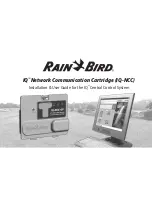
36
WILO SE 10/2022 V05 DIN A4
English SAFETY
The hydraulics must always be earthed. In a standard system,
the hydraulics are earthed through the motor’s connection
to the mains. Alternatively, the hydraulics can be earthed
through a separate connection.
2.5.
Safety and monitoring devices
CAUTION!
Never operate the hydraulics if the attached
monitoring devices have been removed or
damaged, or if they do not work!
NOTICE
Also note all the information in the operating
and maintenance manual for the motor!
The hydraulics are not fitted with monitoring devices as
standard.
Optionally, the sealing chamber can be monitored with an
external pencil electrode.
All existing monitoring devices must be connected by an
electrician and checked to ensure that they function cor-
rectly before commissioning.
The personnel must be informed about the installed systems
and how they work.
2.6.
Conduct during operation
CAUTION! Risk of burns!
The housing parts can heat up to well above
40 °C. There is a risk of burns!
• Never touch parts of the housing with your
bare hands.
• After switching them off, let the hydraulics
cool down to ambient temperature.
• Wear heat-resistant protective gloves.
During operation of the hydraulics, always follow the locally
applicable laws and regulations for work safety, accident
prevention and handling electrical machinery. To help ensure
safe working practice, the responsibilities of employees
should be clearly specified by the operator. All personnel are
responsible for ensuring that regulations are observed.
During operation, all gate valves in the suction and discharge
pipe must be completely open.
If the slide valves on the suction and discharge sides are
closed during operation, the fluid in the hydraulics housing
is heated up by the pumping movement. This heating
creates strong pressure in the hydraulics housing. The
pressure can result in the hydraulics exploding! Before
switching on the hydraulics, ensure that all the slide valves
are open and open any closed slide valves if necessary.
2.7.
Pumped fluids
Each fluid differs with respect to composition, corrosiveness,
abrasiveness, dry matter content and in many other aspects.
Generally, the hydraulics can be used for many applications.
Please note that if requirements change (density, viscosity or
general composition), this can also affect many parameters
of the hydraulics.
When using or replacing the hydraulics to pump a different
fluid, observe the following points:
•
The fluid can be contaminated by oil from the sealing
chamber if the mechanical seal is defective.
Pumping drinking water is not permitted!
• Hydraulics that has been operated to pump contami-
nated water must be cleaned thoroughly before being
used to pump other fluids.
•
Hydraulics that has been operated to pump fluids con
-
taining faeces and/or fluids that are hazardous to health
must be generally decontaminated before being used to
pump other fluids.
First clarify whether the hydraulics may be used to pump
other fluids!
2.8.
Operator responsibilities
2.8.1. Integration into the existing safety concept
The operator shall ensure that the unit is integrated into the
existing safety concept and that it can be switched off in an
emergency using the existing safety shutdowns.
2.8.2. Recommended monitoring devices
The hydraulics are driven by a standard motor. Standard
motors are not overflow-proof. We therefore recommend
using an alarm switchgear to record major leakages. In the
event of a major discharge of fluid (e.g. faulty piping), the
motor must switch off.
2.8.3. Sound pressure
NOTICE
Also note all the information in the operating
and maintenance manual for the motor!
CAUTION: Wear noise protection!
According to applicable laws and regula-
tions, ear protection must be worn if the
sound-pressure level is 85 dB (A) or more! The
end-user must make sure that this is complied
with!
The hydraulics generates a sound-pressure level of approx.
70 dB (A) to 80 dB (A) during operation.
However, the actual sound pressure depends on several
factors. These include e.g. installation, fixation of accessories
and pipe, duty point etc.
We recommend that the operator take an additional meas-
urement at the workplace once the hydraulics is running at
its duty point and under all operating conditions.
2.9.
Standards and guidelines used
The hydraulics is subject to various European directives and
harmonised standards. Refer to the EC declaration of con-
formity for precise information about this.
In addition, various standards are used as a basis for operat-
ing, installing and dismantling the hydraulics.
2.10.
CE marking
The CE marking is attached to the rating plate for the
hydraulics.
















































